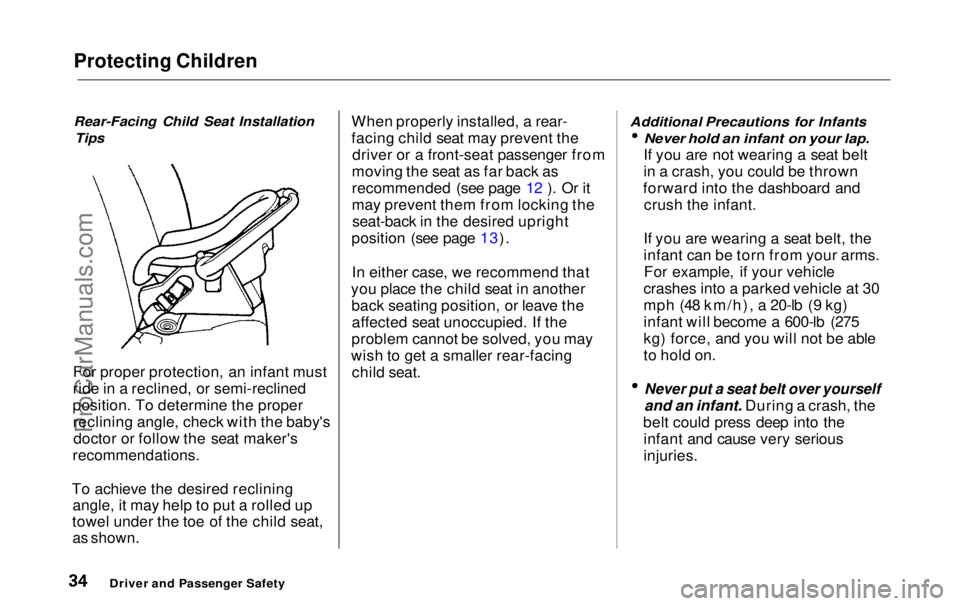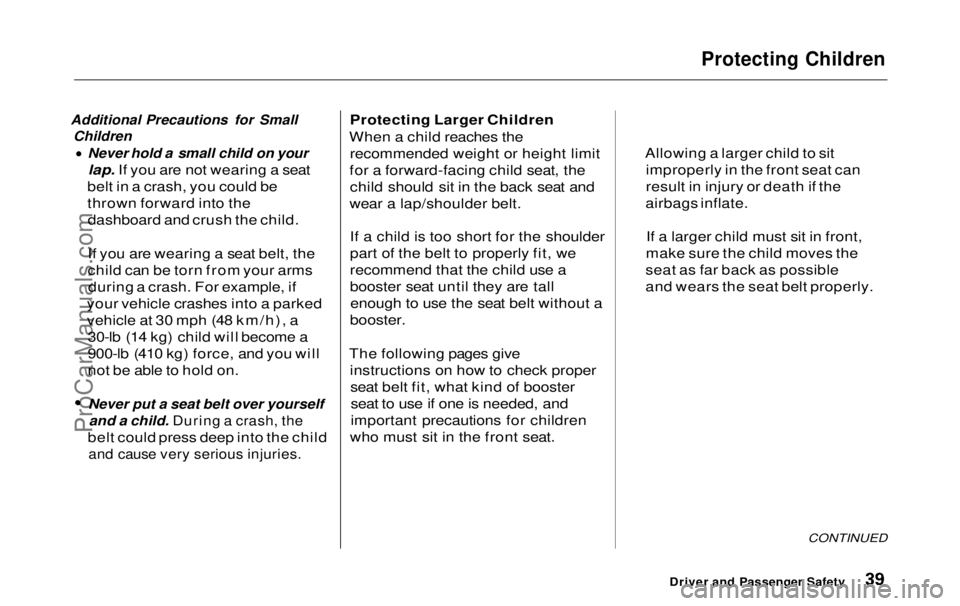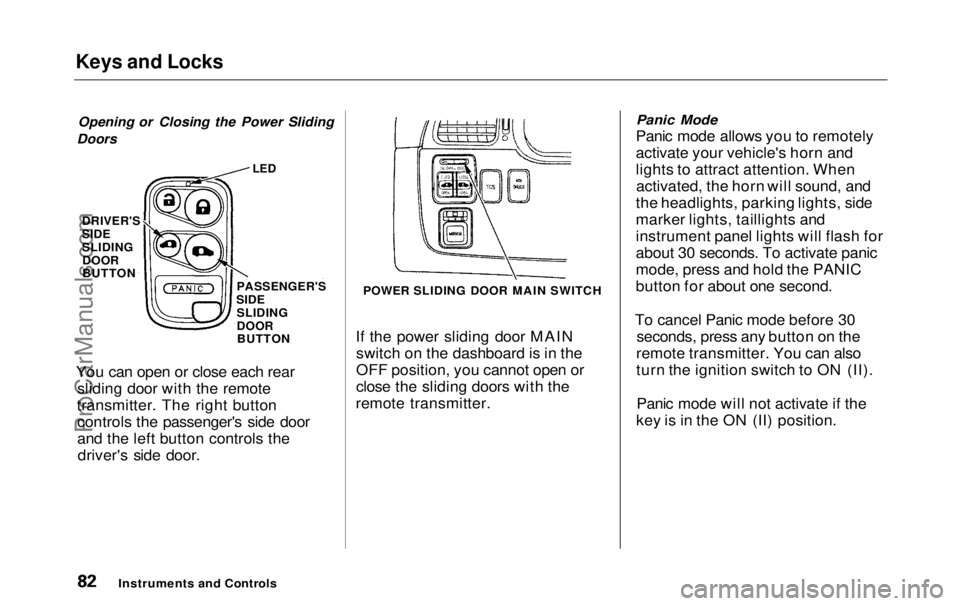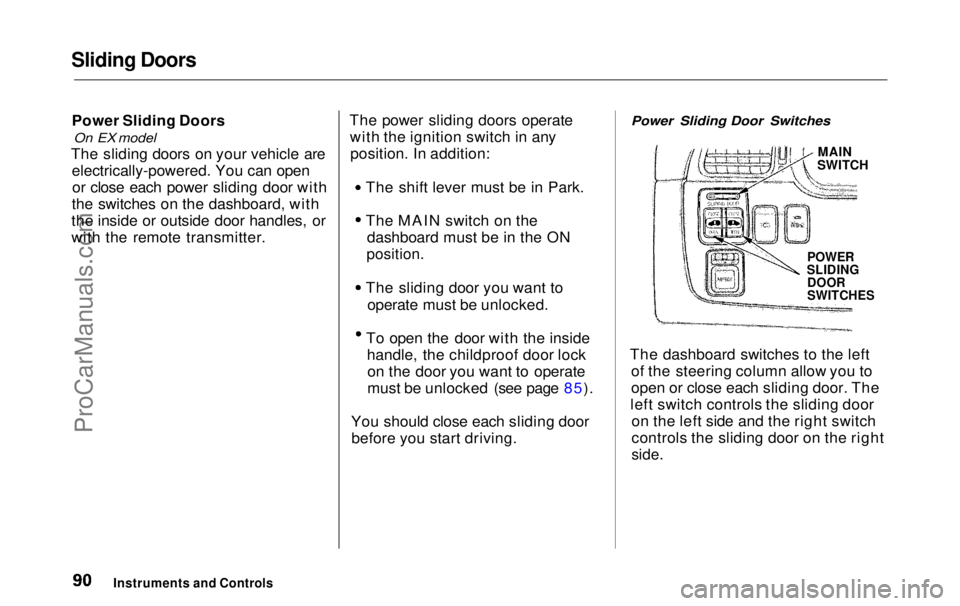Page 35 of 343

Protecting Children
Rear-Facing Child Seat Installation
Tips
For proper protection, an infant must
ride in a reclined, or semi-reclined
position. To determine the proper reclining angle, check with the baby'sdoctor or follow the seat maker's
recommendations.
To achieve the desired reclining angle, it may help to put a rolled up
towel under the toe of the child seat,
as shown.
When properly installed, a rear-
facing child seat may prevent the
driver or a front-seat passenger from
moving the seat as far back as
recommended (see page 12 ). Or it
may prevent them from locking the seat-back in the desired upright
position (see page 13).
In either case, we recommend that
you place the child seat in another back seating position, or leave theaffected seat unoccupied. If the
problem cannot be solved, you may
wish to get a smaller rear-facing child seat.
Additional Precautions for Infants
Never hold an infant on your lap.
If you are not wearing a seat belt
in a crash, you could be thrown
forward into the dashboard and crush the infant.
If you are wearing a seat belt, the
infant can be torn from your arms. For example, if your vehicle
crashes into a parked vehicle at 30
mph (48 km/h), a 20-lb (9 kg)
infant will become a 600-lb (275
kg) force, and you will not be able
to hold on.
Never put a seat belt over yourself
and an infant. During a crash, the
belt could press deep into the infant and cause very serious
injuries.
Driver and Passenger SafetyProCarManuals.comMain Menu Table of Contents s t
Page 40 of 343

Protecting Children
Additional Precautions for Small
Children
Never hold a small child on your
lap. If you are not wearing a seat
belt in a crash, you could be
thrown forward into the dashboard and crush the child.
If you are wearing a seat belt, the
child can be torn from your armsduring a crash. For example, if
your vehicle crashes into a parked
vehicle at 30 mph (48 km/h), a 30-lb (14 kg) child will become a
900-lb (410 kg) force, and you will
not be able to hold on.
Never put a seat belt over yourself
and a child. During a crash, the
belt could press deep into the child
and cause very serious injuries.
Protecting Larger Children
When a child reaches the recommended weight or height limit
for a forward-facing child seat, the child should sit in the back seat and
wear a lap/shoulder belt.
If a child is too short for the shoulder
part of the belt to properly fit, we
recommend that the child use a
booster seat until they are tallenough to use the seat belt without a
booster.
The following pages give instructions on how to check properseat belt fit, what kind of boosterseat to use if one is needed, and
important precautions for children
who must sit in the front seat.
CONTINUED
Driver and Passenger Safety
Allowing a larger child to sit
improperly in the front seat can
result in injury or death if the
airbags inflate.
If a larger child must sit in front,
make sure the child moves the
seat as far back as possible
and wears the seat belt properly.ProCarManuals.comMain Menu Table of Contents s t
Page 49 of 343

Additional Information About Your SRS
SRS Components
Your Supplemental Restraint System (SRS) includes: Two front airbags. The driver's
airbag is stored in the center of
the steering wheel; the front
passenger's airbag is stored in thedashboard. Both are marked "SRS
AIRBAG." Automatic seat belt tensioners
that tighten the front seat beltsduring a moderate to severe
frontal collision. Sensors that can detect a
moderate to severe frontal
collision.
A sophisticated electronic system
that continually monitors the sensors, control unit, the airbag
activators, and all related wiring
when the ignition is ON (II). An indicator light on the
instrument panel that alerts you toa possible problem with the
system (see page 50). Emergency backup power in case
your vehicle's electrical system is
disconnected in a crash. How Your Airbags Work
If you ever have a moderate to
severe frontal collision, the sensors
will detect rapid deceleration and
signal the control unit to instantly
inflate the airbags and activate the
automatic seat belt tensioners.
Driver and Passenger SafetyProCarManuals.comMain Menu Table of Contents s t
Page 61 of 343

Indicator Lights
Power Sliding Door
Indicator
EX model only
This indicator comes on for a few
seconds when you turn the ignition
switch ON (II). If it comes on at anyother time, there is a problem in the
power sliding door system. With this
light on, move the main switch on
the dashboard to the OFF position, and have the system checked by
your Honda dealer as soon as possible. You can still open or closeeach sliding door manually. For
more information on the power
sliding doors, see page 90 . Turn Signal and
Hazard WarningIndicators
The left or right turn signal light blinks when you signal a lane changeor turn. If the light does not blink or
blinks rapidly, it usually means one of the turn signal bulbs is burned out (see page 267). Replace the bulb as
soon as possible, since other drivers
cannot see that you are signalling.
When you turn on the Hazard
Warning switch, both turn signal lights blink. All turn signals on theoutside of the vehicle should flash. Door and Brake Lamp Monitor
The appropriate light comes on in this display if the tailgate or any door
is not closed tightly. If a brake lightdoes not work, the BRAKE LAMP
indicator comes on when you push
the brake pedal with the ignition switch ON (II).
A burned out brake light is a hazard
when drivers behind you cannot tell you are braking. Have your brake
lights repaired right away.
All the lights in the monitor display come on when you turn the ignitionswitch ON (II). The lights go off
after the engine starts and the
tailgate and all doors are closed
tightly.
Instruments and Controls
SLIDING
DOOR
BRAKE LAMPProCarManuals.comMain Menu Table of Contents s t
Page 83 of 343

Keys and Locks
Opening or Closing the Power Sliding
Doors
If the power sliding door MAINswitch on the dashboard is in the
OFF position, you cannot open or
close the sliding doors with the
remote transmitter.
Panic Mode
Panic mode allows you to remotely
activate your vehicle's horn and
lights to attract attention. When activated, the horn will sound, and
the headlights, parking lights, side
marker lights, taillights and
instrument panel lights will flash for
about 30 seconds. To activate panic
mode, press and hold the PANIC
button for about one second.
To cancel Panic mode before 30 seconds, press any button on the
remote transmitter. You can also
turn the ignition switch to ON (II).
Panic mode will not activate if the
key is in the ON (II) position.
Instruments and Controls
You can open or close each rear
sliding door with the remote
transmitter. The right button controls the passenger's side door
and the left button controls thedriver's side door.
LED
PASSENGER'S
SIDE SLIDING
DOORBUTTON
DRIVER'S
SIDE
SLIDING
DOOR
BUTTON
POWER SLIDING DOOR MAIN SWITCHProCarManuals.comMain Menu Table of Contents s t
Page 89 of 343
Sliding Doors
Your Honda is equipped with dual sliding doors. The doors on the LX
model are manually operated. The EX model's doors are electrically-
powered and can be operated with
the remote transmitter, the door
handles, or the switches on the dashboard.
Be sure all passengers are clear of
the sliding doors before closing them. Manual Sliding Doors
On LX model
To open a manual sliding door, pull
the inside or outside door handle and
slide the door backward. It will latch
in the fully-open position. To close
the door, pull either handle and slide
the door closed. Make sure the door
is closed and latched securely before
driving.
Instruments and Controls
OUTSIDE
INSIDE
Closing a manual or power
sliding door while any part of a
passenger is in the door's path
can cause serious injury.
Make sure all passengers are
clear of the doorway before closing a sliding door.ProCarManuals.comMain Menu Table of Contents s t
Page 91 of 343

Sliding Doors
Power Sliding Doors
On EX model
The sliding doors on your vehicle are electrically-powered. You can openor close each power sliding door with
the switches on the dashboard, with
the inside or outside door handles, or
with the remote transmitter. The power sliding doors operate
with the ignition switch in anyposition. In addition: The shift lever must be in Park.
The MAIN switch on the
dashboard must be in the ON
position.
The sliding door you want to
operate must be unlocked. To open the door with the inside
handle, the childproof door lockon the door you want to operate
must be unlocked (see page 85).
You should close each sliding door before you start driving.
Power Sliding Door Switches
MAIN
SWITCH
POWER
SLIDING
DOOR
SWITCHES
The dashboard switches to the left of the steering column allow you to
open or close each sliding door. The
left switch controls the sliding door on the left side and the right switch
controls the sliding door on the right
side.
Instruments and ControlsProCarManuals.comMain Menu Table of Contents s t
Page 92 of 343
Sliding Doors
To close a sliding door, push the top of the appropriate switch, thenrelease it. To open the door, push
and release the bottom of the switch.
The MAIN switch on the dashboard controls door operation. With theMAIN switch off, automatic
operation with the power sliding
door switches, the door handles, and
the remote transmitter is disabled.
When the MAIN switch is off, you can operate each sliding door
manually. To open or close a door,
pull the inside or outside door handle and slide the door.
Operating with the Door Handles
With the sliding door fully-closed or fully-opened, pull the outside orinside door handle and release it.
The sliding door will open or close automatically.
Operating with the Remote
Transmitter
You can open or close the sliding doors with the remote transmitter.
See page 82 for remote transmitter
operation.
CONTINUED
Instruments and Controls
INSIDE
OUTSIDEProCarManuals.comMain Menu Table of Contents s t